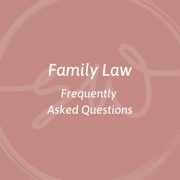Child Support: Get the system to work with you – not against you!
Following separation, you may be entitled to child support, you may have to pay child support or otherwise come to your own tailored arrangement, whereby you share costs of the children. People are often confused by this process, and why wouldn’t you be, separation involves a lot of “firsts”
Broadly speaking there are three ways to address child support:
- Informally, between yourselves
- Formally, with the assistance of the Child Support Agency
- Privately, but registered with the Child Support Agency
Informal Arrangements: Works for Some, a Nightmare for Others!
When you separate, you may agree that the parent who has primary care of the children will receive some money from the other parent to help with the kids. You agree on how much, when and how the child support should be paid and you manage the payments yourselves.
Informal arrangements tend to happen initially when parties separate, for some separated couples they keep this arrangement in place, for others it is non-sustainable. Informal arrangements bring with them the following advantages and disadvantages:
Advantages:
- Control: You decide how much is paid and how it is paid
- Privacy: The Child Support Agency is not involved
- Flexibility: You can make payments in anyway you want, one week send cash and the next pay school fees, do what works for you both
Disadvantages:
- Family Tax Benefit: You may not be eligible to receive family tax benefits if a formal assessment has not been obtained.
- Arrears: If amounts have gone unpaid for some time you cannot seek to collect outstanding amounts. You may be constantly chasing your ex for money.
- Communication: If communication is poor between you both, trying to agree and manage costs without the assistance of a third party can be difficult.
Formal Arrangements: Getting help from the Child Support Agency
Many couples approach the Child Support Agency to assist in determining how much one parent should pay the other to support the children post separation (a Child Support Assessment).
In determining what amount will be paid, the Child Support Agency considers the income of both parties, the age of the children, the number of children, the number of nights that the children are in each party’s care and if either party has children from another relationship. The Child Support web page (humanservices.gov.au) has a handy calculator that can help you estimate what your entitlements or your obligations are.
The Child Support Agency can also:
- Collect and transfer the payments between parents; or
- Determine the amount to be paid but you make private arrangements about the collection and transfer of payments.
Private Arrangements: Set Your Own Boundaries
The third option is a Binding Child Support Agreement, where one party commits to provide child support to the other for a defined period of time. The agreement can include the general periodic child support (for example $200 per week) and non-periodic child support, which can govern the payment of certain expenses such as payment toward the cost of:
- School fees
- Sports costs
- Medical costs and health insurance
- Tutoring
- Extracurricular activities
- Sports lessons and equipment
The benefit of a Binding Child Support Agreement is that you set the perimeters of the agreement, you may decide to enter into an agreement where the payments are lower than or greater than a Child Support Assessment, but for the agreement there is strict criteria:
- Each party must obtain independent legal advice
- The agreement must be in writing and signed by both parties
- You can determine the amount of child support to be paid (be it less than or more than the Child Support Assessment)
- You can make provision for lump sum crediting, for example paying $20,000 in lieu of weekly periodic payments
- You have to make full disclosure of you financial situation
- You register the agreement with the Child Support Agency so they know you have your own formal arrangement in place
However it is very difficult to set-aside an agreement so it is important that before considering this option you obtain independent legal advice to ensure you properly understand how a Binding Child Support Agreement will ultimately affect you and to see if this option is right for you.
In Summary
This article is a snapshot of the child support options available, but every matter is unique and there are considerations that will see one option work for one separated family and not another.
Please do not hesitate to give our Family Law team a call to discuss your situation and to set you on the right path.










Leave a Reply
Want to join the discussion?Feel free to contribute!